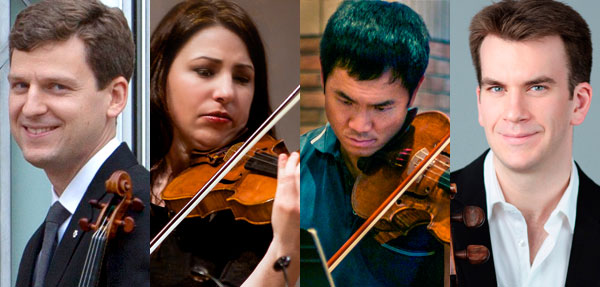
By Dennis D. Rooney
The Gold Room at the Breakers was the venue for the inaugural concert Tuesday of the Palm Beach Chamber Music Society’s fifth season. A replica of a space in Venice’s Gallerie dell’Accademia, the room’s ceiling, lavishly decorated in gold, is painted in a graphic diagonal pattern adorned with 260 hand-carved cherubs.
Surrounding the ceiling are detailed niches, containing 44 hand-painted portraits of Renaissance rulers and explorers of the New World. The space commanded attention, as did the playing of the Ehnes Quartet, founded a decade ago and named for its leader, James Ehnes, who celebrated his 40th birthday last season with a tour of his native Canada.
After welcoming prefatory remarks from Vicki Kellogg, chairwoman of the society’s board, Executive Director Michael Finn, and Ehnes (now a resident of Bradenton) himself, Ehnes then joined his colleagues Amy Schwartz Moretti (second violin), Richard O’Neill (viola) and Edward Arron (cello) in a program that began with the first of Franz Joseph Haydn’s “Erdődy” Quartets, composed in 1797-8 and dedicated to Joseph Georg von Erdődy (1754–1824), a Hungarian count.
The quartets are Haydn’s final set of six and are formally and harmonically among his most sophisticated. Notable in this G Major quartet (No. 60, Hob. III: 75) are the hymn-like passages in the Adagio sostenuto that strongly resemble the famous cantabile movement in the third quartet of the set, the “Emperor” in C.
What Haydn calls a Menuetto in fact plays more like a scherzo, paving the way for Beethoven’s quartet scherzi. Despite their excellent account, the players fell victim to acoustical problems in the room. Loud passages sounded harsh while soft ones lost both quality and intelligibility due to the constant rumble of air conditioning. Under those circumstances, what seemed a limited dynamic compass could easily be excused.
Three of Antonín Dvořák’s Cypresses were heard next. In 1888, he arranged 12 of 18 earlier songs for string quartet. They originated as love songs and despite being shorn of their words, are highly expressive. Again, the residual thrum of the air conditioning made it hard to fully connect with the music’s intimate character, alternatively lyrical, ardent and wistful, although the instrumental color produced by the ensemble’s group of Italian master instruments (viz. the 1715 Marsick Stradivari [Ehnes], a 1754 G.B. Gudagnini [Moretti], the 1727 “ex-Trampler” of Matteo Gofriller [O’Neill] and the 1700 “ex-Cooper” of Giovanni Grancino [Arron]) gave them a lovely burnished quality.
The second of Beethoven’s three “Razumovsky” Quartets, his Op. 59 of 1808, concluded the program. The set inaugurates the composer’s middle-period quartets and expands the expressive range of his Op. 18 set. The Russian nickname is that of an eponymous count who was the Russian ambassador to the Habsburg court. In the trio of the scherzo, Beethoven inserted a Russian folksong (“Glory to the Sun”) supplied by the count, which is familiar to many from its prominent use in the Coronation Scene of Mussorgsky’s Boris Godunov.
The Quartet in E minor is filled with strong dynamic and rhythmic contrasts. The Molto adagio second movement has a marked hymn-like character and is succeeded by what Beethoven calls an Allegretto but is an unmistakable scherzo. Like its successor in the set, Op. 59, No. 2, has a Presto finale of considerable virtuosity. The jogging rhythms of its conclusion are surely the model for the finale of Schubert’s “Death and the Maiden” Quartet.
Like the works performed earlier, the Beethoven was played intelligently and with splendid execution, but the interpretative temperature was cool. Ehnes’s violin sound does not possess a natural seductiveness, which put a decided chill on the slow movement. The opening measures of the Allegretto have a plaintive character that was not phrased sympathetically. A more legato style at many places in the program would have been welcome.